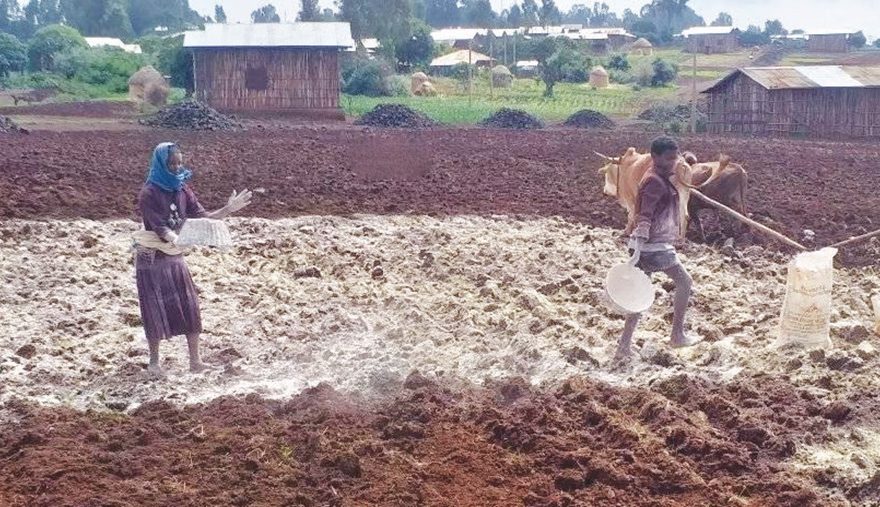
Soil acidity is the concentration of hydrogen ions (H⁺) in the soil, which affects its pH level. Soil acidity can result from natural processes such as rock weathering, organic matter breakdown, and leaching. Furthermore, the use of ammonium-based fertilizers can reduce soil pH over time.
The soil becomes much more acidic when acid rain is brought on by pollution. Acidity will rise if base cations (such as calcium and magnesium) are continuously harvested without sufficient replenishment. For ecosystems to remain healthy and agricultural systems to remain productive, controlling soil acidity is crucial. Proper additions and routine testing can assist attain ideal soil conditions for plant growth.
Ethiopia faces the problem of acidity in its soil, which has an impact on food security and agricultural output. The weathering of volcanic rocks and leaching from excessive rainfall have resulted in naturally acidic soils in several locations of Ethiopia, especially in the highlands.
Acidic soils diminish the availability of important nutrients such as nitrogen, phosphate, and potassium, resulting in lower agricultural yields. As a result, farmers may struggle to grow crops that need neutral or slightly alkaline environments, limiting food diversity and security. Soil acidity also causes nutritional deficits. Acidic soils frequently lack phosphate and calcium, both of which are essential for plant growth. Furthermore, higher solubility of hazardous metals such as aluminum can damage crops and diminish agricultural productivity.
Climate change can also lead to soil acidity since it can worsen problems with soil acidity through altered rainfall patterns and rising temperatures. Therefore, it’s critical to modify agricultural practices appropriately.
Ministry of Agriculture Natural Resource Development, Conservation, and Utilization Executive Director Fanose Mekonon told the Ethiopian press agency that crops require all nutrients in the soil to thrive and yield fruit. They obtain all nutrients through their roots. During this process, they may take unneeded chemicals including acid soil which affects the growth of crops.
According to him, the worsening soil acidity in Ethiopia has become a big threat to the agricultural sector since more than four million hectares of land have been affected by high acidity. Of the four million hectares of land affected by high acidity, one million hectares do not produce any crops. In total, 12 million hectares of land have been categorized into low, medium, and high acid levels. This is a serious threat to the agricultural sector.
The land utilized for agriculture in Ethiopia has been affected by severe rain and soil erosion, totally removing agricultural leftovers that exposed the soil to being heavily acidified. Hence, each year, the soil that has a low acidity level turns into medium acidity while the soil that has a medium acidity level grows too high. Consequently, elevated acidity affects 12 million hectares of land overall.
Rainwater washes away the “catalysts” in the soil, as well as key elements for natural resources such as calcium, magnesium, and potassium, and the soil becomes acidic as the nitrogen and aluminum levels in the soil grow. As a result, this acidic soil inhibits crop growth and prevents complete yield, he noted.
He added that soil acidity burns crops’ roots, limiting their growth and making it harder for air and water to penetrate underground. Furthermore, the soil’s acidity hinders the usage of microbes that feed on the minerals required by crops, as well as the availability of phosphorus, which is necessary for plant growth. As a result, 70 percent of soil fertilizers are not being used, which has an impact on the country’s agriculture and economy sectors.
Highly acidic soil can be found in Western Ethiopia, West and East Wollega, particularly Mendi; East and West Gojam in northern Ethiopia; Awi Zone; Asosa in South Gondar; Benishangul; and the Sidama region in southern Ethiopia.
Taking the issues into consideration, since 2006, attempts have been undertaken to remediate soil acidity in an attempt to boost productivity and production; however, only 140,000 hectares of the 43 percent of land affected by acidity have been treated so far.
In Ethiopia, soil and water protection and management are being implemented to prevent soil acidity, which is a hazard to agriculture. Particularly, the affected soil is being treated using agricultural lime. Currently, one hectare of land consumes 30 quintals of agricultural lime. He stated that once the land has been treated with agricultural lime, it will produce a good yield for four to six years.
Ethiopian Ministry of Agriculture Soil Health and Improvement Desk Head Mulugeta Abera pointed out that soil acidity is increasing in high-rainfall areas of the country. As a result, the country uses agricultural lime to cure the acidic soil. This activity will continue throughout this fiscal year. Accordingly, 300,000 hectares of land will be treated in the current budget year.
According to a 1989 survey, soil acidity affected 40 percent of Ethiopia’s land. The rate has now risen to 43 percent. Soil acidity has grown by 3 percent during the past 27 years. Three percent of arable land is a large amount, and it is not easy. This also demonstrates that soil acidity poses a significant impact on agriculture’s productivity and output.
Furthermore, a national assessment conducted in 2014 revealed that 3.7 million hectares of soil are acidic. According to the study, moderate acidity affects seven million hectares of soil. Even if the best soil fertilizer and seedlings are used, acidic land will not produce yield.
Hence, across the country, several watershed management projects are underway, as well as the application of agricultural lime to acidic soil. As a result, the treated soil, which has been treated using various methods, including agricultural lime, is predicted to yield between 50 and 100 percent. Agricultural lime was used to treat 140,000 hectares of land between 2006 and the present, he elucidated.
To increase production and productivity by preventing soil acidity, the country uses soil fertilizers through research, implements soil and water conservation work, leaves crop leftovers on the farm field, and treats acidic land with agricultural lime. Additionally, natural fertilizers are being used to solve the problem sustainably. This needs the concern of everyone.
In general, controlling soil acidity in Ethiopia is critical to increasing agricultural output and food security. As a result, implementing sustainable management techniques, as well as conducting research and teaching, is critical to addressing this challenge and strengthening Ethiopian agriculture’s resilience.
BY EPHREM ANDARGACHEW
The Ethiopian Herald September 29/2024




